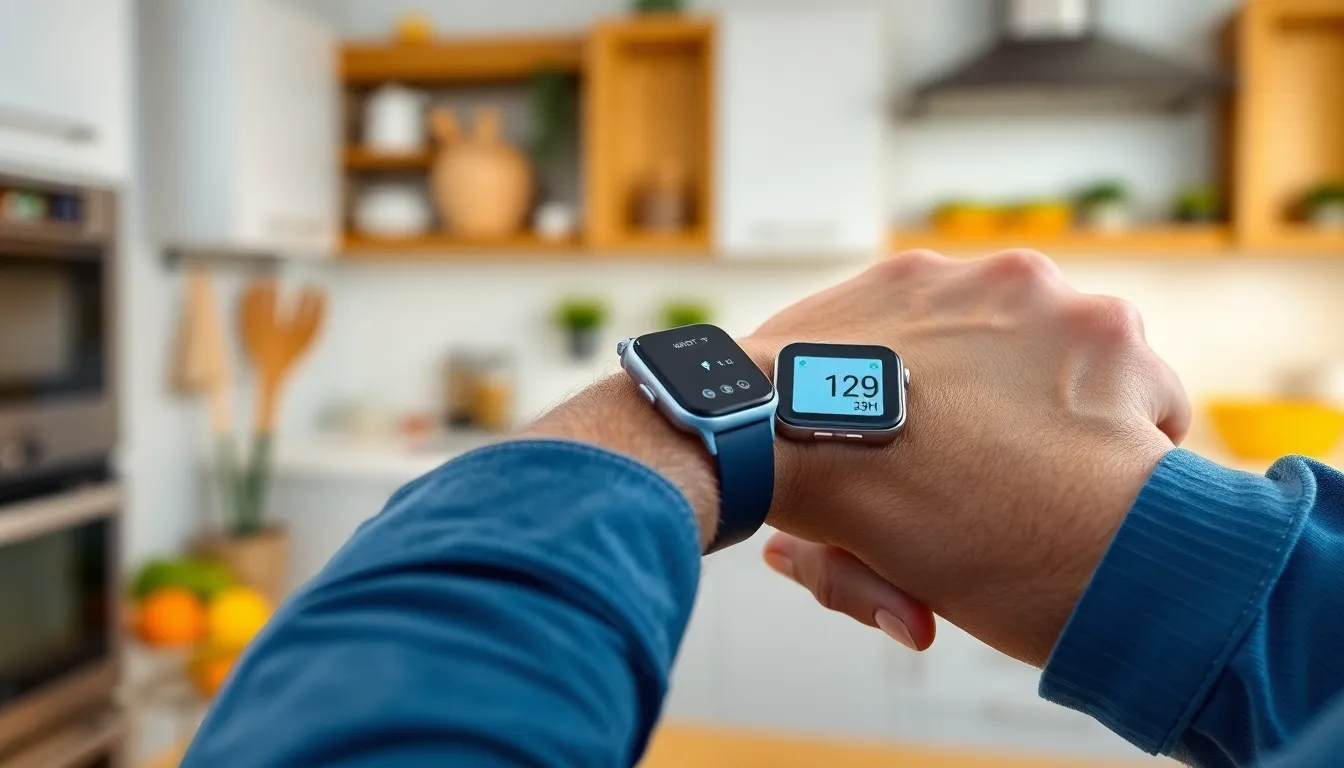Table of Contents
ToggleIn a world where technology’s evolving faster than a cat meme goes viral, managing diabetes just got a high-tech makeover. Enter IoT glucose monitors—your new best friend that’s always got your back (and your blood sugar). These nifty gadgets are here to turn the tedious task of monitoring glucose levels into a seamless experience, allowing users to keep track without the constant finger pricks.
Imagine having a personal assistant that doesn’t just remind you to check your levels but also sends alerts straight to your smartphone. It’s like having a tiny health guru in your pocket, minus the yoga mat and the green juice. With IoT glucose monitors, staying on top of health has never been easier—or more entertaining. Say goodbye to guesswork and hello to real-time insights that empower users to take charge of their health journey with a smile.
Overview of IoT Glucose Monitors
IoT glucose monitors revolutionize diabetes management with their advanced technology. These devices continuously track blood sugar levels, eliminating the discomfort of frequent finger pricks. They integrate seamlessly with smartphones, allowing users to access real-time data and insights effortlessly. Users receive alerts when levels fluctuate, ensuring timely responses to changes in their health.
Various models of IoT glucose monitors come equipped with features like data logging and trend analysis. Data logging provides users with a comprehensive history of glucose readings, which aids in understanding patterns. Trend analysis helps identify factors affecting glucose levels, including food intake and physical activity.
Customization options are another significant benefit. Users can set personalized thresholds for alerts, tailoring their monitoring experience to individual health needs. Many devices also support sharing data with healthcare professionals, facilitating collaborative management of diabetes.
The user interfaces of these devices are often designed for simplicity. Most models feature easy-to-read displays and intuitive navigation. Their advanced analytics assist users in making informed decisions about diet and lifestyle.
Security measures protect sensitive health information. Most IoT glucose monitors encrypt data, ensuring privacy and compliance with health regulations. Manufacturers actively work to enhance security protocols, addressing potential vulnerabilities.
IoT glucose monitors offer an innovative approach to diabetes management. They provide a convenient, efficient, and engaging way to maintain health and improve quality of life. Continuous advancements in technology promise even greater features and benefits for users in the future.
Benefits of Using IoT Glucose Monitors
IoT glucose monitors provide numerous benefits that significantly enhance diabetes management.
Improved Glucose Tracking
Continuous monitoring gives users real-time insights into glucose levels. Alerts prompt users to check their sugar levels before meals or after exercise. Detailed data logging records numbers for trend analysis over time. Identifying patterns allows users to understand fluctuations linked to diet or activity. Insightful analytics simplify decision-making regarding food choices and lifestyle adjustments. Users gain a clearer perspective on their health, making adjustments simpler and more effective.
Enhanced Patient Engagement
IoT glucose monitors promote active involvement in personal health care. Intuitive interfaces encourage users to interact with their data frequently. Customizable alerts ensure users stay informed about their glucose levels. Information sharing with healthcare professionals fosters collaborative management of diabetes. Enhanced communication between patients and providers improves personalized care strategies. Increased engagement leads to better adherence to treatment plans, ultimately enhancing overall health outcomes.
Key Features to Consider
When selecting an IoT glucose monitor, several key features stand out. Understanding these aspects is crucial for making an informed choice.
Accuracy and Reliability
Accuracy greatly impacts the effectiveness of glucose monitors. Devices with high precision provide users with trustworthy readings, crucial for effective diabetes management. Reliable sensors minimize discrepancies between actual glucose levels and displayed values. Users should seek devices that undergo rigorous testing and certification processes to ensure reliability in diverse conditions. Advanced technology, such as continuous glucose monitoring systems, enhances accuracy, offering real-time data that users can rely on, ensuring more consistent health management.
Connectivity and Integration
Connectivity plays a significant role in the overall functionality of IoT glucose monitors. Many models support Bluetooth or Wi-Fi, allowing seamless data transfer to smartphones and health management apps. Integration with third-party applications provides a comprehensive overview of health data, empowering users to track patterns effectively. Some devices even allow direct sharing of information with healthcare professionals for collaborative care. Users benefit from real-time notifications about glucose levels, enabling timely interventions. Enhanced connectivity enhances the overall user experience and promotes engagement in diabetes management.
Popular IoT Glucose Monitor Models
Various IoT glucose monitors are available in the market today, each offering unique features and capabilities.
Model Comparison
Model A features continuous monitoring and seamless smartphone integration, providing real-time glucose readings. Model B stands out with advanced data logging and trend analysis, helping users identify patterns in their glucose levels. Model C offers customizable alerts, allowing users to set specific thresholds for notifications. Many users appreciate Model D’s intuitive interface and ease of navigation, making it user-friendly for all ages. Battery life also varies among these models, with some lasting several days while others require frequent charging. Users should consider connectivity options, as Bluetooth and Wi-Fi functionality improves data sharing with healthcare providers.
User Reviews and Feedback
User feedback highlights the benefits of real-time alerts from these monitors, with many reporting higher engagement in their diabetes management. Reviewers often mention how intuitive interfaces simplify tracking glucose levels. Several users value the ability to share data with healthcare professionals, reporting better collaborative care and improved outcomes. Model A receives praise for its reliability, while others note the accuracy of Model B’s readings. Some feedback indicates challenges with battery length, urging manufacturers to enhance this feature in future versions. Overall, user experiences play a crucial role in determining which model suits individual needs best.
Future Trends in IoT Glucose Monitoring
Advancements in IoT glucose monitoring technology promise to revolutionize diabetes management further. Integration of artificial intelligence into these monitors enhances user experience significantly. Predictive analytics can potentially analyze trends and forecast glucose fluctuations based on historical data.
Greater functionality is anticipated with the introduction of telemedicine capabilities. Remote consultations with healthcare professionals can occur seamlessly within app interfaces. This feature ensures timely adjustments to treatment plans, improving patient outcomes.
Wearable devices are likely to evolve, becoming more comfortable and fashion-forward. Smartwatches or patches might incorporate glucose monitoring, providing users with discreet options. Enhanced battery life is expected as technology improves, addressing one of the main concerns from recent reviews.
Data interoperability is another focus, allowing seamless sharing of health information across platforms and devices. Automated data uploads to electronic health records can facilitate real-time access for medical providers. This connectivity empowers users and healthcare teams to make informed decisions quickly.
Additionally, augmented reality features may enter the market, offering immersive educational experiences. Patients could visualize glucose levels related to diet and activity, enhancing understanding. Gamification elements are also probable, encouraging engagement through rewards and challenges.
Security protocols are set to become more robust, addressing privacy concerns with advanced encryption methods. Users can feel confident that their health data remains protected. Compliance with evolving regulations continues to be a priority for manufacturers.
Overall, these trends emphasize user-centric design and advanced capabilities. Ongoing innovation in IoT glucose monitors aims to enhance self-management, promote engagement, and ultimately improve quality of life for individuals managing diabetes.
Conclusion
IoT glucose monitors are revolutionizing diabetes management by offering users a more intuitive and engaging way to track their health. These devices not only provide continuous monitoring but also empower individuals with real-time insights and personalized alerts. As technology continues to evolve, future advancements promise even greater capabilities, enhancing user experience and fostering collaboration with healthcare professionals. The journey towards better diabetes management is becoming more accessible and efficient, allowing individuals to take charge of their health like never before.





